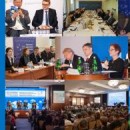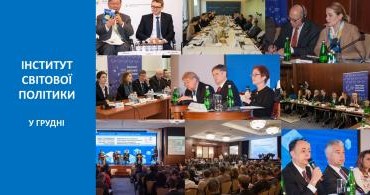An article written by Anton Bendarzsevszkij, Head of the Geopolitical Institute of Russia and Central-Asia (Hungary), based on the results of European thought leaders’ visit to Ukraine which was organized by the Institute of World Policy in partnership with CIDOB.The views expressed in this article are the author’s own and do not necessarily reflect the views of the Institute of World Policy
It was not easy to imagine a strong, strategic alliance of Poland and Romania before 2014 – especially bounded to and around Ukraine. However, this became a geopolitical reality in nearly one and half year fueled by the events in Ukraine. Occupation of the Crimea and the Russian aggression in Ukraine made much more for uniting the NATO alliance and reshaping the relations in the region than any conferences, meetings and summits in the years before.
Forming alliance in Central-Eastern Europe
Bilateral relations of Poland and Romania were not too active before 2014: priorities were different. Romania focused more on its internal affairs and the region around Moldova, and for Poland the Visegrad partnership was the main regional alliance which they were building. Accordingly, the president of Poland, Bronislaw Komorowski has visited Romania only once before 2014, while he came to Hungary four times. For Poland Visegrad Partnership was the priority, and Romania was placed out of the Hungary – Slovakia – Czech Republic – Poland axis.
{1}
VISEGRAD PARTNERSHIP COUNTRIES AND ROMANIA
The situation has rapidly changed after the Russian aggression in Ukraine in 2014. Poland has found itself into new geopolitical realities, facing threats they were not expecting before. The rest of the Visegrad countries however were thinking differently than Poland, and it became clear that Romania was almost the only country in the region, which shares the concerns and views of Poland. Preferences started to change.
For Romania the strategic direction was out of question: Crimea is just 230 km away from the Romanian border, and Transnistria is just 100 km from Romania. The destabilization of the region is a potential threat for Romania. Russian expansion around its borders is a potential threat, and increasing military activity of Moscow in the Black sea is also considered as major threat to Bucharest.
Poland was looking with suspicion towards Russia in the last decade, and started the modernization of its army already back in 2001. As Bronislaw Komorowski said in June 2015 on the GlobSec panel related to European Security: Poland was never so naive about Russia as the rest of Europeans were. Their experience was based on the centuries’ long historic experience, and as Komorowski formulated, “they have learned the lesson”. Poland feels Russia coming closer and closer and is also concerned about the deployment of the Iskander missiles in Kaliningrad.
Based on all that, it was not so surprising, that Warsaw and Bucharest became the main advocates of the military expansion of NATO in the region, building up a defence system on the European periphery. Poland is planning to spend 9,3 billion EUR this year for its defence budget, which makes 2,1% of its GDP, while Romania has also declared that it will increase the defence spending from the current 1,33% of GDP (1,78 billion EUR) to 2% by 2017.
Triangle of Poland, Romania and Ukraine
Romania shares a longer border with Ukraine, than Poland – 530 km against 420 km, but the Ukrainian and Romanian relationship was not cloudless before 2014. Since the collapse of the Soviet Union the two countries have serious disputes regarding the borders at the Black Sea, Romanian minority living in Ukraine and the “bistriy canal” connecting the Black sea and the Danube River on the Ukrainian territory. Kiev and Bucharest were looking at each other with caution trying to figure out if there is a potential threat coming from the other party.
Regime change in Ukraine and the pro-European forces coming to power in Ukraine fundamentally changed these relations and opened a new chapter. Ukraine and Romania have now much more in common than they were expecting: they have common threat coming from Russia, they have common goals and common strategic interests. Poland, which has closer relationship with Ukraine than Romania, can be a pacifier, bringing together the two countries.
The demand for restarted relationship was common both in Kyiv and Bucharest, and the 17 March 2015 president of Romania, Klaus Iohannis visited Kyiv to meet with president Petro Poroshenko – the first visit of a Romanian president to Ukraine in the last seven years. According to Poroshenko, a new chapter was opened in the bilateral relations, and they were able to discuss and find solutions to problems, which were unsolved for many years. The two leaders discussed cooperation in trade, energy, environment, transport, infrastructure and other sectors. Poroshenko has also highlighted, that Romania was the first country to have ratified the Association Agreement of EU and Ukraine.
During the March meeting of the two presidents it was also agreed to work on the unfreezing of the situation in Transnistria, and to strengthen the security of the Black-sea region. What is probably more important: new regional cooperation was outlined on the meeting, drawing a triangle between Poland, Ukraine and Romania.
“We must increase regional cooperation between Ukraine, Poland and Romania, and create a certain group of solidarity” – told Mr. Iohannis on the meeting.
{2}
TRIANGLE OF POLAND – ROMANIA AND UKRAINE
Few days before Mr. Iohannis’ visit to Kyiv, the Romanian president also met with his Polish colleague, Bronislaw Komorowski on 12 March 2015, which also fitted into the new strategic outline. The two signed an agreement in the energetic cooperation and agreed to provide a concrete European perspective to Ukraine, Moldova and Georgia – countries of the Eastern Partnership, which signed the association agreement with EU.
Winning of Andrzej Duda on the Polish presidential elections in May can also play in favor for Poland and Romania: Duda was criticizing Komorowski for not doing enough against the Russian aggression. Duda was also speaking against the “Normandy format” dealing with the situation in Ukraine, and was advocating for including the neighbours, Poland, Slovakia, Hungary and Romania into the negotiation process. His victory in the polish presidential elections may move forward the Poland-Romania-Ukraine cooperation even faster.
NATO expansion in Central-Eastern Europe
The deployment of the European missile defense system was already on NATO’s agenda since 2002, however, because of the mixed reception in EU and the restart of US-Russia relations after 2008 the deployment was halted. In the phase 1 the Aegis ballistic missile defense system was deployed on a US warship, USS Monterey, which was sent to the Mediterranean and later to the Black sea area in 2011.
Officially, the deployment plans were never canceled and a roadmap was created introducing three phases of European missile system deployment. However, Russian actions in Crimea and Eastern Ukraine have definitely accelerated the process and made the participating states much more willing to cooperate. So far Russia had a very strong voice against NATO expansion in Europe, but with its recent actions Moscow has lost all the credibility, and provided the legitimacy for defensive actions from NATO’s side. In phase 2 the Aegis Ashore missile defence system will be deployed to Romania in 2015 to provide coverage for Southern Europe, and in phase 3 the second Aegis Ashore facility will be deployed to Poland until 2018, to provide coverage for Northern Europe.
In the last months, the US made it clear that Romania and Poland are its most important allies in the region. Since the beginning of the year Romania was already visited by several high ranked US and NATO representatives, including Jens Stoltenberg (NATO Secretary-General), Victoria Nuland (US assistant secretary of state for European and Eurasian Affairs), General Philip M. Breedlove (NATO Supreme Allied Commander – Europe) and Frank A. Rose (US Assistant Secretary for Arms Control, verification and compliance).
Poland and Romania also seem to be the least dependent countries in the region from Russian energy resources and economic sector. Romania’s consumption of the Russian gas is just 20% of its total gas consumption. Poland’s use of Russian gas is worth of 60% its total consumption of gas, but this year Poland also opens a new liquefied gas terminal at Swinoujscie, which will definitely decrease this number.
Base for regional cooperation
Russia was also not idle in the last years: several sources point out that Moscow has deployed Iskander-M tactical ballistic missile system in Kaliningrad area, and according to Rostec, they are planning to deploy 120 new systems by 2020. Iskander missile systems, originally developed in the Soviet Union and modernized recently, have a 400 km strike radius. The facts that Warsaw is just 275 km away from Kaliningrad (or Bucharest 383 km away from Tiraspol) definitely make the European leaders to feel nervous. Moscow has also upgraded its radar capabilities in Kaliningrad, according to the deputy defense minister, Yuri Borisov. The Voronezh-DM class radar is in par with foreign counterparts, and can track up to 500 targets simultaneously within 6000 km range.
Signals are clear: the Russian aggression started in 2014 against Ukraine means a very direct threat and challenge to European security order, and thus a threat to European prosperity and development. The remilitarization of the Black Sea, military campaign in Eastern-Ukraine, the deployment of Iskander missiles, the rise of regional nationalism supported by Kremlin and the destabilization of Ukraine, Moldova and Transnistria are all threats which we are facing right now. All these threats can only be dealt effectively together, with a regional cooperation. A Triangle, outlined by Poland, Romania and Ukraine, aimed on defending Europe’s borders and helping Ukraine to deal with Russian aggression, can be a good base for it. A well working, successful cooperation should also attract the neighbours into this strategic alliance on the later stages: Bulgaria, Czech Republic, Hungary and Slovakia.
The initiative was implemented due to the support:
“Ukraine National Initiatives to Enhance Reforms” (UNITER) project, funded by the U.S. Agency for International Development (USAID) and implemented by the Pact in Ukraine;
Friedrich Ebert Foundation in Ukraine;
“Initiative on the think tanks development in Ukraine”, operated by International Renaissance Foundation in partnership with the Think Tank Fund (TTF) and funded by the Embassy of Sweden in Ukraine (SIDA).






Comments themeComments themeComments themeComments themeComments themeComments themeComments themeComments themeComments themeComments themeComments themeComments themeComments themeComments themeComments themeComments themeComments themeComments themeComments themeComments.